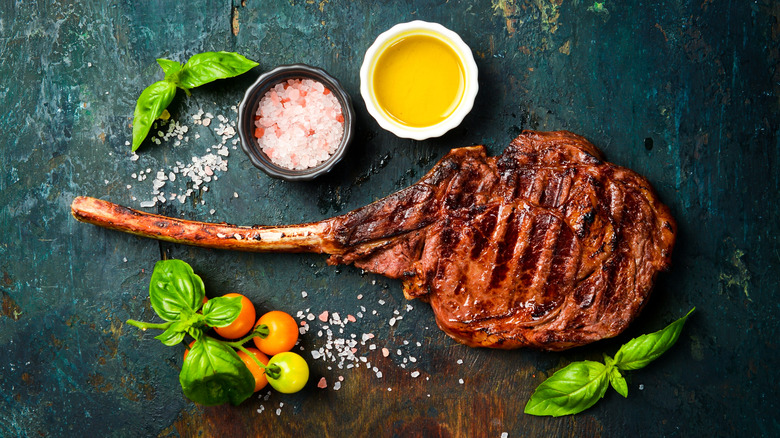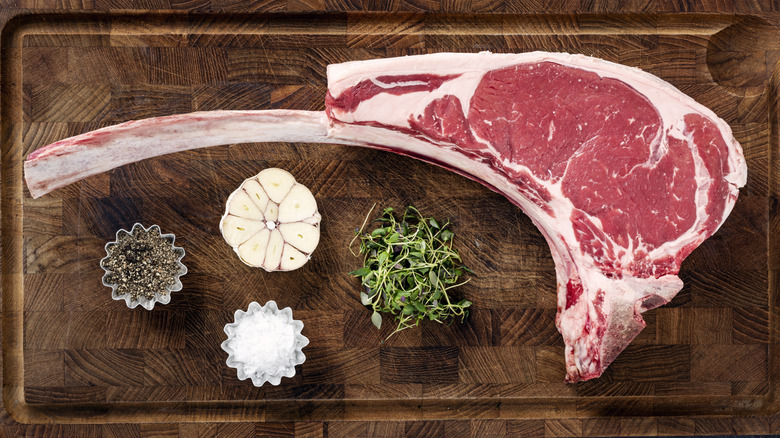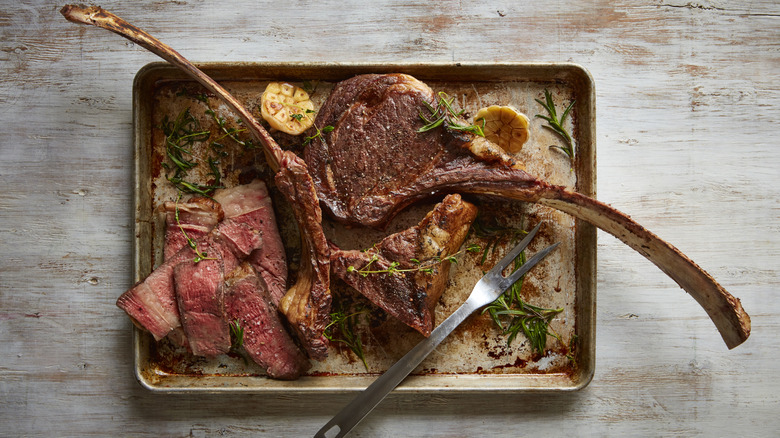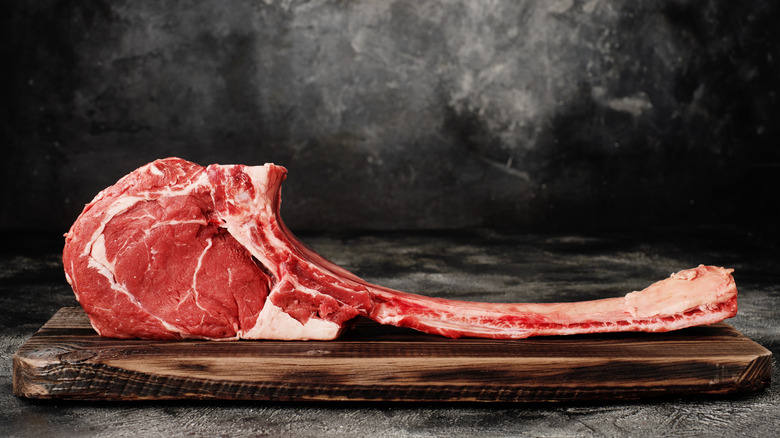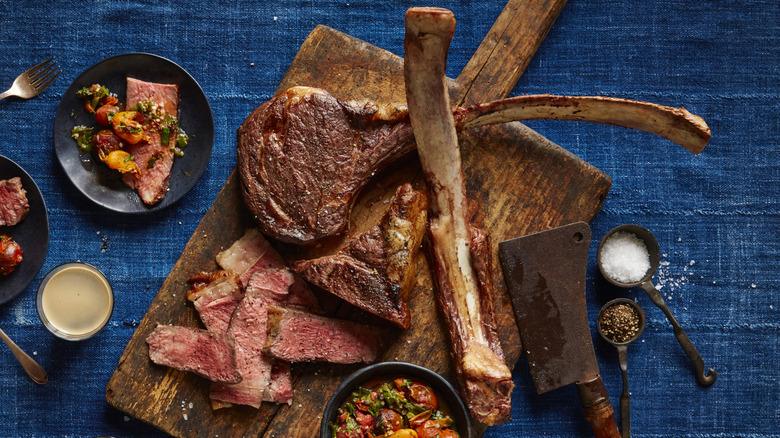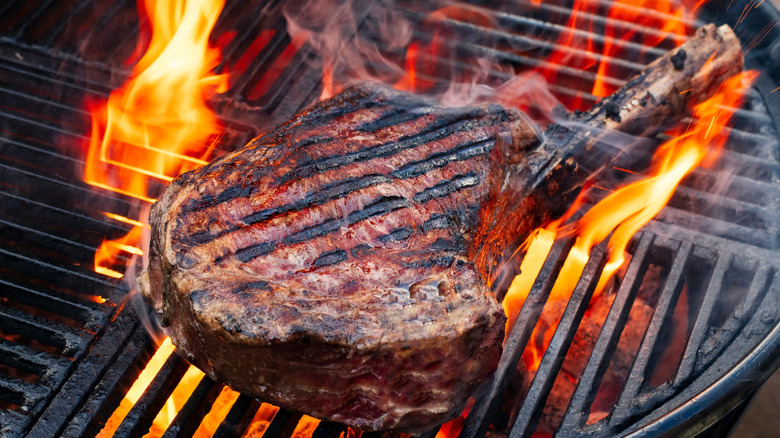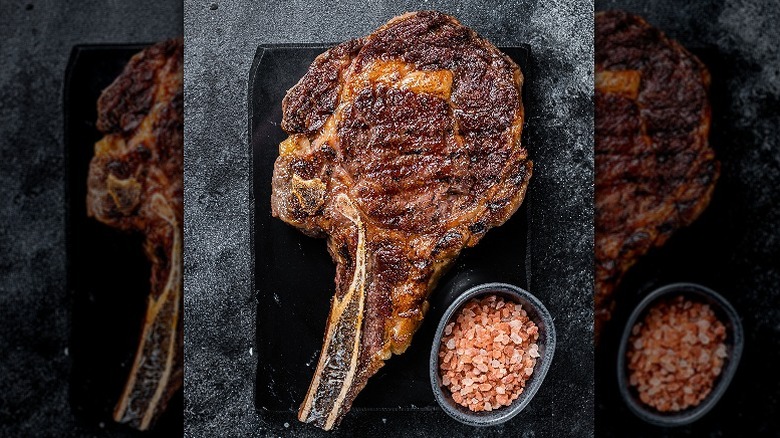9 Facts You Need To Know About Tomahawk Steaks, According To A Chef
If you gaze longingly at a tomahawk steak instead of purchasing one because you're afraid of destroying it, you're not alone. The majestic tomahawk steak can be an intimidating cut of meat to master, but it's as tasty as it is grand. This marbled piece of beef features a lengthy bone that resembles an ax handle, hence the name. The bone is a notable feature that makes this steak cut so memorable and sought-after. It's also one of the reasons this prized cut of beef is somewhat expensive. To find out more about this long-handled, well-marbled beauty, we reached out to Drew Rosenberg, executive chef at CUT by Wolfgang Puck in Beverly Hills, to gather the facts about a tomahawk steak.
Some — probably most — steak enthusiasts consider a tomahawk steak a top-of-the-line cut. Sourced from the rib primal, chef Rosenberg tells us, "A tomahawk is a ribeye with an extended rib bone." The tomahawk is a quality cut of meat, but it's important to know what to look for to select your best option. "The steak should... have a vibrant, rich color, which indicates freshness," Rosenberg advises. "There should be no odor to the tomahawk." If you're not cooking a tomahawk steak yourself, you can also find this cut on the menu at some of the best steakhouse chains in the U.S.
The cut has become synonymous with fine dining
A tomahawk steak makes such a bold statement that it has become synonymous with celebration and luxury dining, says chef Drew Rosenberg. This giant, thick cut of steak is on the end of a lengthy, polished bone. The whole thing grabs your attention, sparking the desire to pick it up like a meat lollipop. A tomahawk steak requires an extra large plate, and yet, it's a rather elegant cut. It weighs around 3 to 4 pounds but represents higher-end dining, in part due to its hefty price tag, says chef Rosenberg.
In addition to its size and grandeur, the reason a tomahawk steak is a bit pricey, chef Rosenberg tells us, is due to sourcing and limited supplies. "Each cow only yields about 14 of these impressive cuts," he says, "making them a delicacy." Since there are only a small amount of tomahawk cuts per cow and preparation for each steak involves skilled cutting and cleaning, the price tends to be higher than cuts that come from other parts of the cow, like the chuck or round. "The substantial size and weight also play a factor as it offers the ability to feed more than two people," he says. This cut is typically shared among multiple people, making it a good choice as the centerpiece for a small party.
A quality cut has a clean, polished bone with well-marbled meat
Getting a quality tomahawk cut is essential if you want to truly enjoy your big steak experience. A good quality cut exhibits meat with rich color and solid bones (if it's bone-in, of course). "Make sure to request a tomahawk that is at least 2 inches thick," chef Drew Rosenberg tells us, "to ensure a satisfying dining experience." A worthy tomahawk features well-marbled meat with a blemish-free bone. When it comes to the bone, he tells us, "The bone shouldn't have any cracks as this would indicate that it's dry and old."
Not only does the quality of your cut contribute to taste and texture, but it also affects the aesthetics, which some consider stunning. The signature bone of a tomahawk goes through a process referred to as frenched. "A quality tomahawk will have a clean, polished handle bone with no remnants of fat or meat attached," chef Rosenberg says. Cleaning the bone contributes to the lengthy look of the handle and is part of the overall package. Though a large part of the appeal is the dinosaur-size bone, it's the meat that matters more. "Look for marbling," he says, "[because] an even distribution of white fat ensures flavor and tenderness."
It features a high fat content
The tomahawk cut, as we previously stated, comes from the rib prime of the cow, and any meat coming from this area is often coveted for its fatty nature. Much like a ribeye, says chef Drew Rosenberg, "[A tomahawk] is going to be one of the highest fat content steaks." The tomahawk cut comes from the same place as ribeye, rib roast, or a rack of ribs; it's just a matter of how it's skillfully cut from the cow.
Considered one of the fattiest steaks you can buy, meat from the rib area naturally features more intramuscular fat, which is what creates the intense marbling throughout the meat. "The extra fat gives it rich flavor and tenderness," says chef Rosenberg. There are some who argue a ribeye is actually too rich, so if you prefer a lean piece of meat, you might want to skip the tomahawk and go for the sirloin. But for those who enjoy a hearty bite of beef, the marbling in a tomahawk delivers a juicy, buttery mouthful.
Wrapping the bone preserves its natural look during cooking
Chef Drew Rosenberg suggests covering the bone when you cook a tomahawk steak if you're interested in retaining the bone's natural look. The best way to cook a tomahawk steak involves either the oven or grill, which means the use of both direct and indirect heat. At times, the bone will be exposed to high flames or heat, as well as a long cook time since a tomahawk is thick and averages a few pounds in weight. When the bone is subjected to high heat or flames, the bone chars, becoming blackened and far less appealing. The bone may also split or crack. But does this matter to the meat?
Chef Rosenberg says that it's not necessary to protect the bone during cooking unless you're looking to make it a show-worthy display. "Covering the bone is optional," he says, "and based solely on your preferred presentation." Wrapping the bone shields it from the heat and flames, greatly reducing the chance of a black, charred bone. It may also help reduce the temperature of the bone. "If you plan to cover it," chef Rosenberg says, "...wrap it in foil to ensure it remains white and helps prevent the bone from cracking."
The bone doesn't provide extra flavor
The larger-than-life bone of the tomahawk steak certainly makes for a great presentation and conversation starter. It's also attached to some of the best beef you'll ever taste, but the bone itself, chef Drew Rosenberg tells us, doesn't actually contribute much flavor to the meat. "While the bone itself doesn't provide flavor," he says, "you'll get a slight flavor influence from the little extra fat attached to the bone." So go ahead and gnaw on that bone to get those last bits of meat; no judgment here.
But even if the bone doesn't provide much extra flavor for the meat, our appetite begins with our eyes. "The bone is a showstopper and visually appealing," chef Rosenberg says. There's something about a tomahawk steak that speaks to the instinctual side of our taste buds. The sight of one sparks the salivary glands to spring into action and begin the digestion process. So, you might be able to argue that seeing the impressive bone of a tomahawk enhances the flavor of the meat because your taste buds are heightened.
A leftover tomahawk bone makes great bone broth
If it wasn't already clear, one of the main draws to the tomahawk steak is the king-size bone that doubles as a handle. The very look and name of this steak cut are perfect for holding and waving it above your head or taking a large bite for the camera. "Social media has really elevated the tomahawk status," chef Drew Rosenberg tells us, "turning it into an "Instagrammable" moment." Besides whipping out your phone to snap a few shots — adjusting your angles and lighting — and then posting the photos to social media, chef Rosenberg has another suggestion: create a beef bone broth with the leftover bone.
There are a few things to consider when making bone broth. Chef Rosenberg warns us the bone will provide minimal flavor, but it can be smoked or roasted to achieve a deeper and richer addition to your broth. Any leftover meat, fat, or collagen on the bone will only enhance your broth. Consider adding apple cider vinegar, which may help break down the collagen and offset the fat. Don't be afraid to toss in herbs and spices as well. Not ready to make a batch of broth? Don't throw the bone out — save it in the freezer in an airtight container to make broth at a later date.
Reverse sear is the optimal way to cook it
Chef Drew Rosenberg recommends the reverse sear method for cooking a tomahawk steak. Reverse sear is a popular cooking method for many cuts of meat, and the tomahawk is no exception. Even though the sheer size of this cut makes it a challenge to cook in the first place, tomahawk benefits in many of the same ways as a bone-in ribeye, like a high-heat sear. Because of its size, searing and cooking a tomahawk steak requires a grill, broiler, or super large pan. However, the reverse sear method follows the same steps regardless of the cut.
Chef Rosenberg walks us through the process, "Essentially, you'll start by cooking the steak in a slow oven at 250 F degrees to get that edge-to-edge doneness. Once it hits an internal temperature of 120 F degrees," he says, "transfer it to a blazing hot grill for a quick sear." The final internal temperature before your sear will depend on how you like your steak cooked. With an internal temperature of 120 F, chef Rosenberg tells us, "This... will give you a beautiful crust while keeping the inside perfectly medium-rare," which is his personal favorite way to enjoy a tomahawk. "I love mine cooked a medium-rare plus, around 125 F degrees to 130 F degrees, which strikes that ideal balance of juiciness and flavor."
They're popular for special celebrations
In a similar way that the tomahawk cut is aligned with luxury dining, it's also popular for special celebrations, says chef Drew Rosenberg. When it's a special occasion, people often spend more and choose to enjoy something that isn't regularly a part of their life, like going to a reputable steakhouse and ordering a top menu item. "Tomahawks are very popular at CUT Beverly Hills — we do 7 or 8 a night," chef Rosenberg tells us. It's typically larger parties that order the tomahawk because they're a good size to share, he says, which is "the perfect way to celebrate a special occasion." The grand centerpiece of a tomahawk steak makes for a memorable experience, which people like to document via photos and social media.
With the popularity of social media platforms, it's not surprising that they have a bit of influence over potential menu items. Chef Rosenberg tells us there is a rise of high-end steakhouses adding tomahawk steak to the menu, due in part to social media posts and photos. Hey, in the meat lover's world, the tomahawk steak is a treat and worthy of a photo shoot.
Cowboy ribeye is a budget-friendly alternative
Whether the tomahawk steak is intimidating or just a little out of your price range, the cowboy ribeye is a great alternative, says chef Drew Rosenberg. "[It's] basically a mini tomahawk," he says. A cowboy ribeye is a smaller cut with a shorter bone, but it's sourced from the same area of the cow. This cut is sometimes confused with a bone-in ribeye since they're so similar. But more like a tomahawk, a cowboy ribeye is a thick, hefty cut. "If you want a similar flavor without the same presentation," Rosenberg says, "then the cowboy ribeye is a great option."
If you're unable to find a cowboy ribeye or obtain one from a butcher, a bone-in ribeye is your next best selection for a similar kind of cut. It may not be as glamorous for photos or an over-the-top dining centerpiece, but cook a ribeye the right way, and it will at least be the shining star of your plate.

